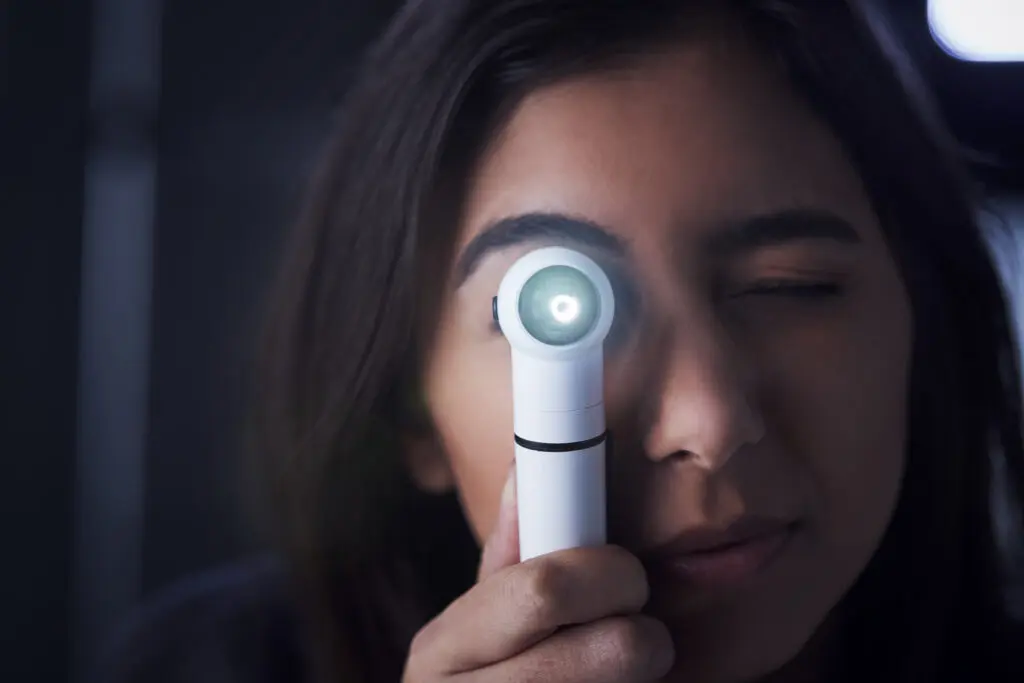Following Functional Vision Evaluation, our team makes every effort to ensure that all findings and diagnoses are communicated in language that is easily understood. While we make every effort to use “plain english” phrasing throughout our reports, we still must adhere to use of proper Optometric terminology when summarizing groups of findings and formulating conclusions and recommendations.
Below is a reference to be used following your Functional Vision Evaluation to help make sense of the top diagnoses that we see in the clinic. Most Functional Vision Evaluations will result in 2-3 of the findings outlined and described below.
As a note, these brief descriptions are meant to be used as a guide and will be expanded on in person or over the phone during your report review session. Should you have any questions pertaining to your particular report, please don’t hesitate to contact us via the contact information provided on this site.
| DIAGNOSES | DESCRIPTION | COMMON FUNCTIONAL IMPACT |
|---|---|---|
| Accommodation (Subcategories Below) | Disorder of the internal “ciliary” muscle that controls our ability to comfortably focus, and make objects clear. | |
| Accommodative Excess | “Accommodative muscle working too hard, thereby over focusing when viewing targets.” | Visual fatigue, aversion to near work and headaches while reading or on the computer. Struggles in busy visual scenes. Targets may appear to move faster than they actually are. |
| Accommodative Insufficiency | “Accommodative muscle is not working hard enough, thereby under focusing when viewing targets.” | Visual fatigue, aversion to near work and headaches while reading or on the computer. Struggles in busy visual scenes. Difficulty tracking and keeping up with fast moving targets. |
| Accommodative Instability | “Poor control of the accommodative muscle.” | Visual fatigue, aversion to near work and headaches while reading or on the computer. Struggles in busy visual scenes. Targets appear to move either slower or faster than they actually are. |
| Accommodative Infacility | “Poor flexibility (near->far->near transitions) of the accommodative muscle.” | Difficulty transitioning focus from near to distance, and back again (i.e. copying from board, driving). Issues with balance, depth perception and sensations of dizziness are very common. |
| Vergence (Subcategories Below) | Disorder of the external “extraocular” muscles (there are 6 of them) that control the ability to comfortably align our two eyes and keep targets single. | |
| Convergence Excess | “Convergence muscles are working too hard, thereby over-converging when viewing targets.” | Visual fatigue and headaches while reading or on the computer. Struggles in busy visual scenes. Targets may appear to move faster than they actually are. |
| Convergence Insufficiency | “Convergence muscles are not working hard enough, thereby under-converging when viewing targets.” | Visual fatigue and headaches while reading or on the computer. Frequently report words as doubling, blurring or moving and/or “swimming” on the page. Struggles in busy visual scenes. Difficulty keeping up to fast moving targets. |
| Divergence Insufficiency | “Divergence muscles are not appropriately relaxing and aligning the eyes well in the distance.” | Struggles in busy visual scenes. Targets may appear to move faster than they actually are. Subtle instances of double vision, or intermittent blur when viewing distant targets is common. |
| Divergence Excess Exotropia | “Divergence muscles are not appropriately relaxing and aligning the eyes well in the distance. One eye tends to drift outwards as a result.” | Struggles in busy visual scenes. Difficulty tracking and keeping up visually with fast moving targets. Subtle instances of double vision, or intermittent blur when viewing distant targets is common. Issues with balance, gross motor control and depth perception are very likely. |
| Vergence Infacility | “Poor flexibility (near->far->near transitions) of the vergence muscles.” | Difficulty transitioning focus from near to distance (i.e. copying from board, driving). Issues with balance, depth perception and sensations of dizziness are very common. |
| Post Trauma Vision Syndrome | “Timing between your central (parvocellular) and peripheral (magnocellular) visual streams are not in sync. Not integrating central and peripheral information well.” | Light sensitivity, motion sensitivity, dizziness, nausea, headaches and aversion to near-centred visual engagement (i.e. reading, computer work, phones) are very common. Post Trauma Vision Syndrome as a diagnoses comprises a collection of Optometric findings, further described HERE. |
| Visual Midline Shift (Left, Right, Up or Down) | “Patient is perceiving visual space either right, left, up or down from where it actually is.” | Frequent reports of light sensitivity and extreme motion sensitivity. Issues with balance, depth perception and sensations of nausea and dizziness are very common. Visual Midline Shift as a diagnosis is further described HERE. |
| Oculomotor Dysfunction (Subcategories Below) | Inability to comfortably separate head movements from eye movements. Should generally be developed by 6-7 yo. Persistent difficulties in this area will greatly affect reading skills and attention. | |
| Deficiency of Pursuits | “Inability to comfortably separate head movements from slow tracking eye movements.” | Struggles in busy visual scenes. Difficulty keeping up with fast moving targets. Issues with attention and gross motor/fine motor control are very common. Frequently must “touch” objects to learn and derive meaning. |
| Deficiency of Saccades | “Inaccurate saccades, which are the rapid eye movements used while reading.” | Struggles in busy visual scenes, along with major difficulties with eye tracking skill while reading (frequent regressions and loss of place on the page). Issues with attention and gross motor/fine motor control are very common. Frequently must “touch” objects to learn and derive meaning. |
| Amblyopia | Decreased visual clarity in one eye, relative to the other. | |
| Refractive Amblyopia | “The decreased clarity is due to an asymmetrical glasses prescription (higher prescription on one side).” | Poor eye tracking speed and fluency while reading. Issues with balance, depth perception and gross motor control are very common. |
| Strabismic Amblyopia | “The decreased clarity is due to an eye that turns either up, down, in or out, relative to the other.” | Poor eye tracking speed and fluency while reading. Issues with balance, depth perception and gross motor control are very common. |
| Tropias | One eye is deviated (either in, out, up or down) the majority of the time. | |
| Esotropia | “One eye is turning inwards – primarily at near. Strong prescriptions or bifocal glasses are typically worn by these patients to help keep the eyes aligned.” | Poor eye tracking speed and fluency while reading. Issues with balance, depth perception and gross motor control are very common. Periodic double vision is common. |
| Exotropia | “One eye is turning outwards relative to the other.” | Poor eye tracking speed and fluency while reading. Issues with balance, depth perception and gross motor control are very common. |
| Hypertropia, or Hyperphoria-Decompensating | “One eye is deviated upwards relative to the other.” | Poor eye tracking speed and fluency while reading. Issues with balance, depth perception and gross motor control are very common. Periodic double vision is common. |
| Visual Perceptual Deficit | Brain is struggling to make sense of and organize the visual information that it receives. | |
| Visual Discrimination | “Ability to recognize differences in visual images.” | Trouble seeing the difference between similar letters, shapes, or objects. Struggles to recognize similar words or phrases when encountered in different locations while reading. |
| Visual Memory | “Ability to retain or recall visual detail.” | Struggle to remember shapes, symbols, or objects seen, commonly resulting in issues with reading and spelling. |
| Visual Spatial Relationships | “Ability to perceive the position of objects relative to each other.” | Trouble understanding where objects are in space; unsure how close objects are to one another. Frequent letter reversals and struggles with math are common. Often described to be rather “clumsy.” |
| Visual Sequential Memory | “Ability to remember visual details in the correct sequence.” | Find it difficult to see shapes, letters, or words in the correct order; often skip lines or read the same line over and over. |
| Visual Figure Ground | “Ability to focus on a specific piece of visual information in a busy background.” | Struggle to distinguish a shape or letter from its background. Frequent loss of place while reading, or “clumsy-like” demeanour in busy visual scenes. |
Until next month
Dr. Paul Rollett, OD, FCOVD




